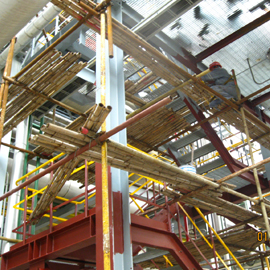CAUSES OF BUBBLES IN EPOXY ZINC-RICH PRIMER COATING
(2022年08月07日)https://www.paint-in-china.com/causes-of-bubbles-in-epoxy-zinc-rich-primer-coating.html
Epoxy zinc rich primer is widely used in industrial anti-corrosion and has excellent corrosion resistance. It is well-matched with other intermediate paints and topcoats. It is mainly used in the anti-corrosion of steel structures, bridges, engineering equipment, and mechanical facilities.
However, some problems are often encountered during construction, and blistering of the paint film is one of them.
Coating blistering is a common zinc primer coating defect in the construction of epoxy zinc-rich primer. It often occurs between the primer and the substrate, or between two coatings, and sometimes occurs in a single coating. There are large and small blisters. The size of the blisters usually depends on the adhesion strength to the substrate, or the bonding ability between the coatings, and the pressure in the blisters.
Causes of bubbles in epoxy zinc primer paint
1. The soluble pigment in the primer absorbs moisture, and the moisture passes through the coating to produce a relatively concentrated solution. Therefore, the probability of air bubbles is relatively high. If the paint contains soluble substances or there are soluble salts on the substrate or between the coatings, penetration blisters will occur.
2. There are sundries on the surface of the substrate, such as grease, wax and dust, which reduce the adhesion of the coating. Moisture will penetrate towards areas where the coating has low adhesion.
3. When using cathodic protection and coating systems at the same time, if the cathodic protection is too much and a sufficient amount of hydrogen is generated on the metal substrate under the coating, the resulting pressure will cause blistering.
4. On the surface of the corroded old steel, because of the presence of salt and oxide in the corroded holes, it is easy to cause pitting and blistering. The corrosive gas will pass through the coating and be absorbed, react with the surface of the substrate, and the pressure generated will arch the coating film. Welding fumes during electric welding can also cause this problem.
5. The solvent in the anti-corrosion coating evaporates poorly and remains in the coating, which can also cause blistering. The sensitivity of the solvent to water can increase the absorption of water molecules by the coating film and the transfer of moisture in the coating. If the adhesion of the anti-corrosion coating itself is not good, as the water resistance decreases, the coating will foam. The surface temperature of the coating will also make the residual solvent generate enough vapor pressure to cause the coating to blister.
The above points are the reasons why the epoxy zinc-rich primer is prone to foaming when the construction personnel encounters such coating defects. According to the actual situation, a comprehensive analysis can be made and corresponding solutions can be made.
POPULAR FEATURED FUXI ® PAINTS
Rubber Modified Acid and Akali Resistance Anticorrosive Paint China
General-Purpose Chlorinated Rubber Anticorrosive Coating (Self-Priming Paint for Ships)
Elastic Polyurethane Anti Corrosive Oil
If you want to know more about blistering defect in coating, please contact us.
- このできごとのURL:



コメント